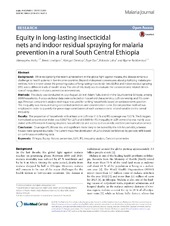Equity in long-lasting insecticidal nets and indoor residual spraying for malaria prevention in a rural South Central Ethiopia
Hailu, Alemayehu; Lindtjørn, Bernt; Deressa, Wakgari; Gari, Taye; Loha, Eskindir; Robberstad, Bjarne
Peer reviewed, Journal article
Published version

Åpne
Permanent lenke
https://hdl.handle.net/1956/12542Utgivelsesdato
2016-07-16Metadata
Vis full innførselSamlinger
Originalversjon
https://doi.org/10.1186/s12936-016-1425-0Sammendrag
Background: While recognizing the recent achievement in the global fight against malaria, the disease remains a challenge to health systems in low-income countries. Beyond widespread consensuses about prioritizing malaria prevention, little is known about the prevailing status of long-lasting insecticidal nets (LLINs) and indoor residual spraying (IRS) across different levels of wealth strata. The aim of this study was to evaluate the socioeconomic related dimension of inequalities in malaria prevention interventions. Methods: This study was conducted in July–August 2014 in Adami Tullu district in the South-central Ethiopia, among 6069 households. A cross-sectional data were collected on household characteristics, LLIN ownership and IRS coverage. Principal component analysis technique was used for ranking households based on socioeconomic position. The inequality was measured using concentration indices and concentration curve. Decomposition method was employed in order to quantify the percentage contribution of each socioeconomic related variable on the overall inequality. Results: The proportion of households with at least one LLIN was 11.6 % and IRS coverage was 72.5 %. The Erreygers normalized concentration index was 0.0627 for LLIN and 0.0383 for IRS. Inequality in LLIN ownership was mainly associated with difference in housing situation, household size and access to mass-media and telecommunication service. Conclusion: Coverage of LLIN was low and significant more likely to be owned by the rich households, whereas houses were sprayed equitably. The current mass free distribution of LLINs should be followed by periodic refill based on continuous monitoring data.
